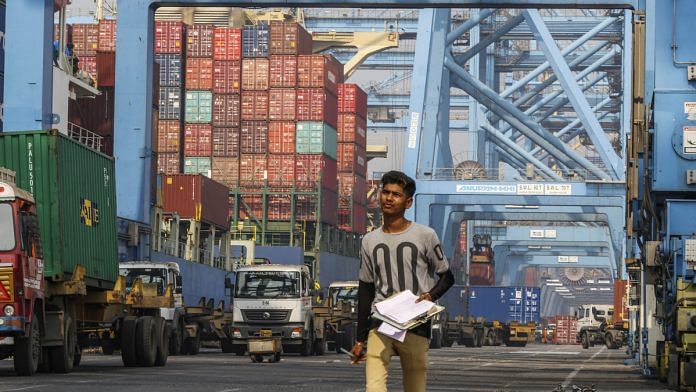Geneva: The Covid-19 pandemic was supposed to put the final nail in the coffin of globalization and prompt a retreat into a new era of protectionism. Instead, some are now calling the crisis the Great Accelerator.
The drop in international commerce was quick and steep during the first coronavirus lockdowns, but a rebound fueled by emergency fiscal and monetary stimulus has been almost as sharp. Global trade is finishing the year on a strong upswing.
Following two years of the U.S.-China tariff war, trade carried out through sprawling networks of suppliers — the bogeyman of protectionism backers — are acting as lifelines to consumers and shock-absorbers for many businesses. Companies like Samsonite International SA to Walgreens Boots Alliance Inc. are reinforcing their sources of production abroad instead of retreating from global markets.
“What we have learned is supply chains are flexible and adaptable,” World Trade Organization Chief Economist Robert Koopman said in an interview. “Trade is part of the solution.”
Evidence of trade’s solid 2020 comeback is pouring in this week from several export bellwethers in Asia:
- South Korea said its exports returned to growth last month, led by gains in major markets such as the U.S. and the European Union.
- China’s Caixin Media PMI for manufacturing soared to a decade-high last month, and a separate official gauge of China’s manufacturing out Monday showed exports fueled faster-than-expected activity in November.
- A PMI reading on Japanese factories returned to its pre-pandemic level, while Taiwan rose to the highest since 2018.
Natalie Blyth, the global head of trade financing at HSBC Holdings Plc, isn’t seeing companies recoil supply chains to their domestic markets to protect against new risks. On the contrary.
She holds the view that the pandemic is acting as the “great accelerator” when it comes to trade, particularly with the aid of technology, as companies strengthen regional bases while eyeing a burgeoning middle class of some three billion consumers across Asia.
“I’ve tried to find it — I can’t find the reshoring. We can find reshaping,” Blyth said. “The super efficient, finely tuned just-in-time inventory model failed in phase one of Covid. But it’s not reshoring that’s the solution to that — it is diversification.”
Also read: Maruti Suzuki expects 2021 to be ‘much better’ as economy rebounds & people buy more cars
No retreat
At the beginning of the year the WTO predicted global trade flows could fall by as much as 32%, which would have exceeded the worst decline of the Great Depression.
If current figures hold through the fourth quarter, the WTO projects global merchandise trade will only fall by 9.2% in 2020, which is less than the 12% drop in global trade in 2009 at the height of the financial crisis.
In response to the pandemic, multinational companies are developing new ways and finding new places to produce their goods.
Take the example of Samsonite, the luggage maker that’s been on the receiving end of trade’s twin shocks of the past three years: tariffs and travel bans. The Mansfield, Massachusetts-based company next year will get less than 35% of its products for North America from China, down from 95% two years ago, an executive said on a conference call last month.
Samsonite’s supply chain now extends to Thailand, Vietnam and Cambodia. “This team has really done an amazing job of shifting and the quality of what we’re getting outside of China is as good as ever,” CEO Kyle Francis Gendreau said.
Meanwhile, China’s appetite for agricultural commodities like corn, soybeans, wheat and sorghum remains “quite strong,” said Archer-Daniels-Midland Co. Senior Vice president Greg Morris during a recent presentation. “So even despite the pandemic, global trade flows are actually increasing this year versus previous years.”
Another key factor in the resilience of the global trading system was the decision by nations to resist their most protectionist instincts, and U.S. President-elect Joe Biden is vowing to re-engage in multilateral efforts.
Governments generally adhered to their WTO commitments and kept trade open and flowing during the first wave of the virus, according to the WTO’s latest report on G-20 trade restrictions. Among those economies, trade subjected to import-restrictive measures unrelated to Covid-19 dropped to $42.9 billion between mid-May and mid-October — down from $417.5 billion during the previous five-month period.
“Governments learned lessons from past experiences that stopping trade flows is problematic,” Koopman said. “There may be challenges to globalization but it helps facilitate a recovery.”
The speedy development of vaccines is itself a product of globalization, with investment and scientific expertise being shared across borders, and production hubs and distribution channels forming around the world.
Koopman said governments will need to enact further fiscal and monetary measures to soften the blow for companies and workers that are again seeing their livelihoods disrupted.
Then again, “if the vaccine comes through and prospects brighten and consumers become optimistic and start spending, fiscal stimulus may not be as needed,” Koopman said.-Bloomberg
Also read: GDP, inflation forecast for FY21 could see upward revision as RBI reviews monetary policy



